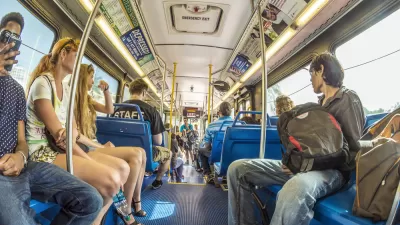First, let me begin by introducing myself. I am Parris Glendening, and I serve as the president of the Smart Growth Leadership Institute in Washington, D.C., which is part of Smart Growth America. From 1995-2003, I was Governor of Maryland, and for more than 20 years before that I served at various levels of local and county government. I am excited about being part of the network of contributors here at Planetizen and participating in the discussion.---In 1956 Pres. Dwight Eisenhower shepherded the Interstate Highway into existence, fulfilling a decades-long aspiration to link the nation with highways that could move both people and materiel as efficiently as those he had seen in Germany. Later, he would warn us against the military-industrial complex, but with a bit more foresight he might have warned against the asphalt-industrial complex, as well.
---
In 1956 Pres. Dwight Eisenhower shepherded the Interstate Highway into existence, fulfilling a decades-long aspiration to link the nation with highways that could move both people and materiel as efficiently as those he had seen in Germany. Later, he would warn us against the military-industrial complex, but with a bit more foresight he might have warned against the asphalt-industrial complex, as well.
 Tysons Corner is a suburb of Washington, D.C., just outside the Beltway. The once-sleepy crossroads is now one of the main employment centers of the region, home to the equivalent of one-third of the office space in D.C. proper. Several years ago, the Washington Area Metropolitan Transit Authority and Virginia officials began planning a Metrorail extension through Tysons Corner and Fairfax County to Dulles Airport. But while the service was welcome, the plan to run it on an elevated track provoked a groundswell of opposition among business owners, citizens, and local leaders.
Tysons Corner is a suburb of Washington, D.C., just outside the Beltway. The once-sleepy crossroads is now one of the main employment centers of the region, home to the equivalent of one-third of the office space in D.C. proper. Several years ago, the Washington Area Metropolitan Transit Authority and Virginia officials began planning a Metrorail extension through Tysons Corner and Fairfax County to Dulles Airport. But while the service was welcome, the plan to run it on an elevated track provoked a groundswell of opposition among business owners, citizens, and local leaders.The core of the problem is a fundamental flaw in the system of funding at the FTA, which elevates short-term number-crunching over community impacts and long-term benefits.
 FTA officials told Kaine that switching to a tunnel would jeopardize the federal funding, even if Virginia found other sources to cover the more expensive, but longer-lasting tunnel option. Never mind that the tunnel would be far less disruptive to businesses and residents during construction, or that it would spur many times as much investment along the corridor, or that it would simply help make Tysons a more people-friendly place to be. It cost more, and that was the end of that.
FTA officials told Kaine that switching to a tunnel would jeopardize the federal funding, even if Virginia found other sources to cover the more expensive, but longer-lasting tunnel option. Never mind that the tunnel would be far less disruptive to businesses and residents during construction, or that it would spur many times as much investment along the corridor, or that it would simply help make Tysons a more people-friendly place to be. It cost more, and that was the end of that. www.smartgrowthamerica.org
www.sgli.org

Alabama: Trump Terminates Settlements for Black Communities Harmed By Raw Sewage
Trump deemed the landmark civil rights agreement “illegal DEI and environmental justice policy.”

Study: Maui’s Plan to Convert Vacation Rentals to Long-Term Housing Could Cause Nearly $1 Billion Economic Loss
The plan would reduce visitor accommodation by 25% resulting in 1,900 jobs lost.

Planetizen Federal Action Tracker
A weekly monitor of how Trump’s orders and actions are impacting planners and planning in America.

Federal Homelessness Agency Places Entire Staff on Leave
The U.S. Interagency Council on Homelessness is the only federal agency dedicated to preventing and ending homelessness.

Restoring Northern India’s Himalayan ‘Water Temples’
Thousands of centuries-old buildings protect the region’s natural springs and serve as community wells and gathering places.

Milwaukee to Double Bike Share Stations
Bublr Bikes, one of the nation’s most successful, will add 500 new e-bikes to its system.
Urban Design for Planners 1: Software Tools
This six-course series explores essential urban design concepts using open source software and equips planners with the tools they need to participate fully in the urban design process.
Planning for Universal Design
Learn the tools for implementing Universal Design in planning regulations.
Caltrans
Smith Gee Studio
Institute for Housing and Urban Development Studies (IHS)
City of Grandview
Harvard GSD Executive Education
Toledo-Lucas County Plan Commissions
Salt Lake City
NYU Wagner Graduate School of Public Service




























